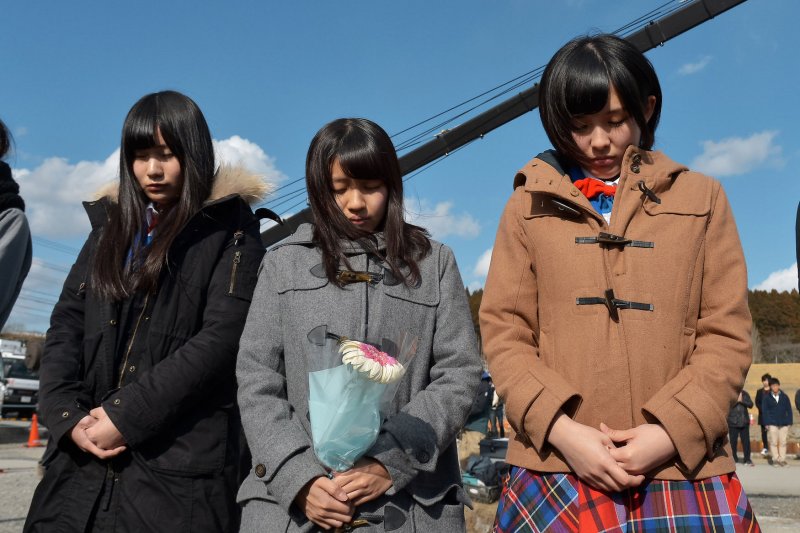1 of 14 | Women bow their heads and offer a silent prayer in front of the government building in Minamisanriku in Miyagi prefecture, Japan, on March 11, 2016. Photo by Keizo Mori/UPI |
License Photo
TOKYO, March 11 (UPI) -- Japan's emperor and prime minister led a solemn ceremony in Tokyo Friday marking the fifth anniversary of the tsunami and earthquake in Fukushima.
The tidal wave and magnitude-9 earthquake killed nearly 20,000 people as it overwhelmed entire towns in northeastern Japan and triggered a partial meltdown at the Fukushima Daiichi power plant. Five years later more than 180,000 people remain displaced, and 100,000 people are still unable to return home because of local radiation leaks.
At 2:46 p.m. Friday, the exact anniversary of the earthquake, the nation observed a moment of silence, with Tokyo's trains, traffic and pedestrians coming to a halt, after which temple bells rang. In a nationally televised ceremony, Emperor Akihito, 82, and Empress Michiko, 81, joined Prime Minister Shinzo Abe in a ceremony honoring the dead.
"Many of the people affected by the disaster are aging, and I worry that some of them may be suffering alone in places where our eyes and attention don't reach. It is important that all the people keep their hearts together so that not a single person still in difficulty is overlooked and they can return to normal life as soon as possible," the Emperor told an audience of 1,200. He and his wife, a frail but beloved couple in Japan, spent the weeks after the disaster visiting emergency shelters and consoling survivors.
Abe acknowledged the difficulties of rebuilding, saying, "Reconstruction is steadily making progress, step by step, with housing being rebuilt and jobs regained. Many people are still leading uncomfortable lives in the affected areas. There are many who cannot return to their beloved homes because of the accident at the nuclear power plant. We commit ourselves to providing care for their minds and bodies, forming new local communities and supporting industrial development of the affected areas...Japan will continue to show the world the lessons learned from (the disaster) and the way we are recovering."
Ceremonies were also conducted in the area of the disaster, including Rikuzentakata, where 1,700 died in the tsunami and rebuilding has been slow.
"The reality is that we still feel the scars here, and there are still many struggling to restart their lives," said local resident Yashichi Yanashita.
Government data indicate about 2,500 people remain listed as missing, and as of September 2015, 3,410 had died from illnesses and suicides linked to the disaster.
All Japanese nuclear power plants, responsible for about 30 percent of the country's electrical needs, were shut down after the incident, and Japan's energy policy was rewritten; the Japanese remain skeptical of nuclear energy as a power source, James D.J. Brown of Temple University in Tokyo noted. The fast response of the Japanese military in dealing with the disaster, however, helped boost its image in the eyes of pacifist-leaning Japanese citizens.















